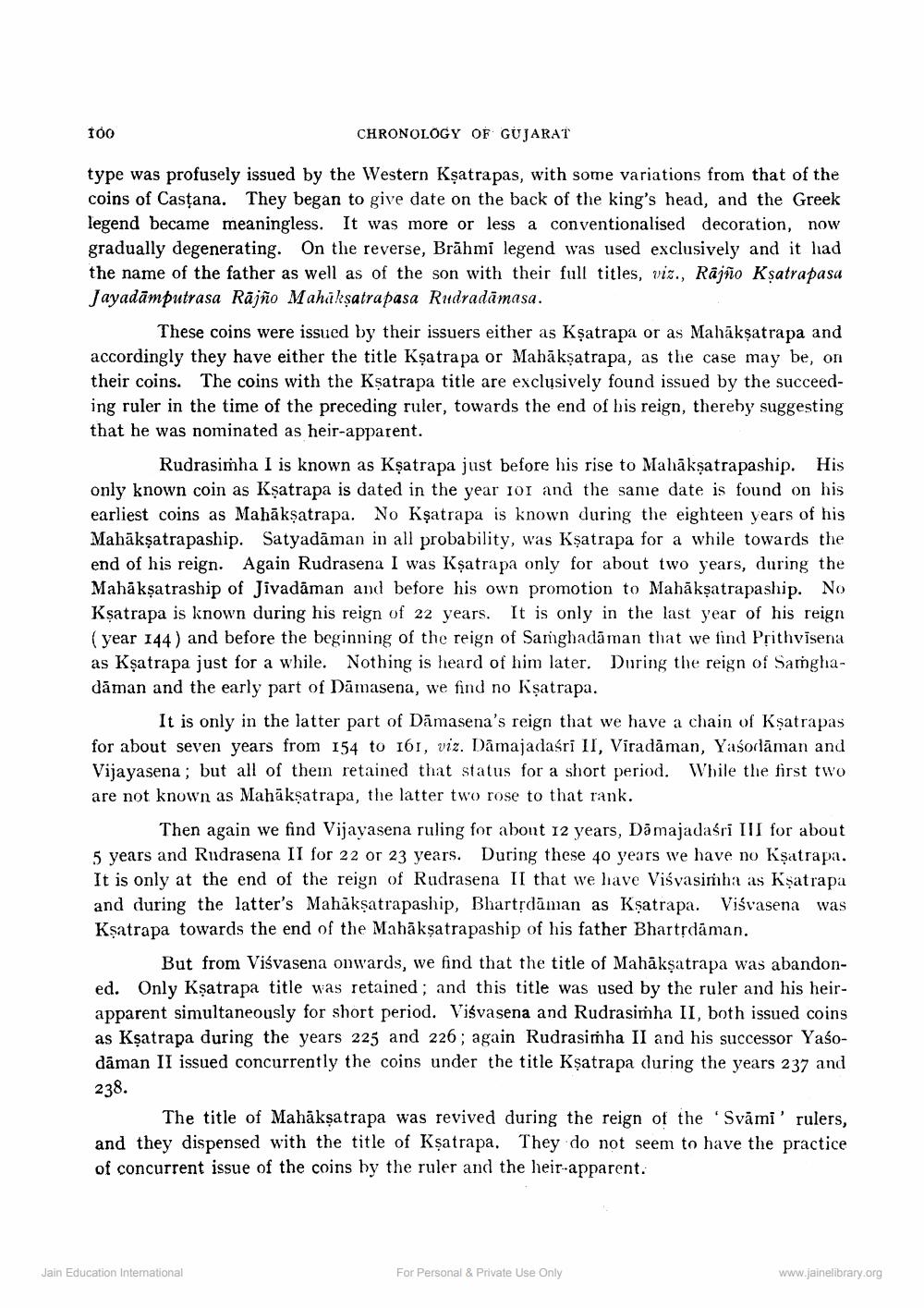________________
CHRONOLOGY OF GUJARAT
type was profusely issued by the Western Ksatrapas, with some variations from that of the coins of Castana. They began to give date on the back of the king's head, and the Greek legend became meaningless. It was more or less a conventionalised decoration, now gradually degenerating. On the reverse, Brahmi legend was used exclusively and it had the name of the father as well as of the son with their full titles, viz., Rajo Kṣatrapasa Jayadamputrasa Rajño Mahakṣatrapasa Rudradāmasa.
100
These coins were issued by their issuers either as Ksatrapa or as Mahākṣatrapa and accordingly they have either the title Ksatrapa or Mahākṣatrapa, as the case may be, on their coins. The coins with the Kṣatrapa title are exclusively found issued by the succeeding ruler in the time of the preceding ruler, towards the end of his reign, thereby suggesting that he was nominated as heir-apparent.
Rudrasimha I is known as Ksatrapa just before his rise to Mahākṣatrapaship. His only known coin as Kṣatrapa is dated in the year 101 and the same date is found on his earliest coins as Mahākṣatrapa. No Ksatrapa is known during the eighteen years of his Mahākṣatrapaship. Satyadāman in all probability, was Kṣatrapa for a while towards the end of his reign. Again Rudrasena I was Kṣatrapa only for about two years, during the Mahākṣatraship of Jivadaman and before his own promotion to Mahākṣatrapaship. Not Kṣatrapa is known during his reign of 22 years. It is only in the last year of his reign (year 144) and before the beginning of the reign of Samghadaman that we find Prithvisena as Ksatrapa just for a while. Nothing is heard of him later. During the reign of Samghadaman and the early part of Damasena, we find no Ksatrapa.
It is only in the latter part of Dimasena's reign that we have a chain of Ksatrapas for about seven years from 154 to 161, viz. Dāmajadaśrī II, Vīradāman, Yasodaman and Vijayasena; but all of them retained that status for a short period. While the first two are not known as Mahākṣatrapa, the latter two rose to that rank.
Then again we find Vijayasena ruling for about 12 years, Damajadaśri III for about 5 years and Rudrasena II for 22 or 23 years. During these 40 years we have no Kṣatrapa. It is only at the end of the reign of Rudrasena II that we have Viśvasimha as Ksatrapa and during the latter's Mahakṣatrapaship, Bhartṛdäman as Kṣatrapa. Viśvasena was Ksatrapa towards the end of the Mahākṣatrapaship of his father Bhartrdaman.
But from Viśvasena onwards, we find that the title of Mahākṣatrapa was abandoned. Only Kṣatrapa title was retained; and this title was used by the ruler and his heirapparent simultaneously for short period. Viśvasena and Rudrasimha II, both issued coins as Ksatrapa during the years 225 and 226; again Rudrasimha II and his successor Yasodaman II issued concurrently the coins under the title Ksatrapa during the years 237 and
238.
The title of Mahākṣatrapa was revived during the reign of the 'Svåml' rulers, and they dispensed with the title of Ksatrapa. They do not seem to have the practice of concurrent issue of the coins by the ruler and the heir-apparent.
Jain Education International
For Personal & Private Use Only
www.jainelibrary.org




